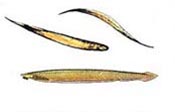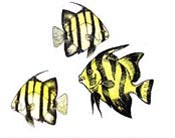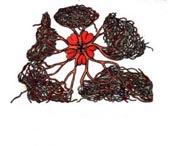| For a typical visitor to the marine lab the experience is new and exciting, but it can also be confusing. How can a sea squirt have anything to do with a fish? What is a sea cucumber? Are these animals or plants? Our signs and story boards make it clear and describe the unique ecological aspects of the Florida panhandle coast. These displays consist of large panels with text and colored drawings that hang over the sea water trays and on the walls. The signs depict a wide variety of habitats ranging from shallow mud flat, oyster bar bottoms, and lush sea grass, to offshore sandy shell bottoms with limestone coral rock outcrops.
These pictures and the ones in our catalog are available free for educational use and may be printed and placed in a binder or posted. Click the species name to link it to the catalog, and click the catalog name to return. |
|
 |
Amphioxus – Branchiostoma floridae, Subphylum: Cephalochorda, an extremely important organism that zoologists consider to be the link between invertebrates and vertebrates. They have a “notachord” that represents the forerunner of a backbone. Also called “Florida Lancelets” they can swim through sand about as fast as a fish can swim through water. |
 |
Atlantic Spadefish – Chaetodipterus faber, Family: Ephippidae, common to Florida and Caribbean waters, schools of Spadefish are frequently seen on the small crabs and shrimp around dock pilings and old crab traps. Large adults (1-3″) may not have the distinctive silver and black vertical banks. |
 |
Basket Starfish – Astrophyton muriatum, this living “spanish moss” of starfish is found in deep water attached to sponges and rocks. At night it expands its net of tentacles to catch plankton in the water. They come in a great array of colors ranging from reds, oranges, white and black. |
 |
Black Drum – Pogonias cromis, looks similar to a sheepshead with its black and white vertical stripes. They feed on worms and crustaceans in the soft mud bottoms. They are the noisiest of the drum family, combining their drumming with a sort of purring by vibrating a muscle that is close to the swim bladder. The bladder acts like an amplifier for the sound. |
| Next » | |
